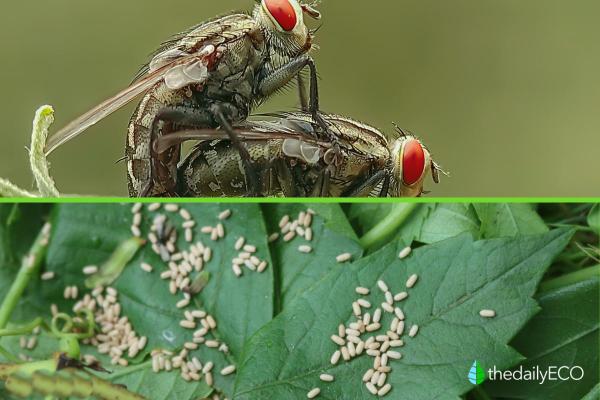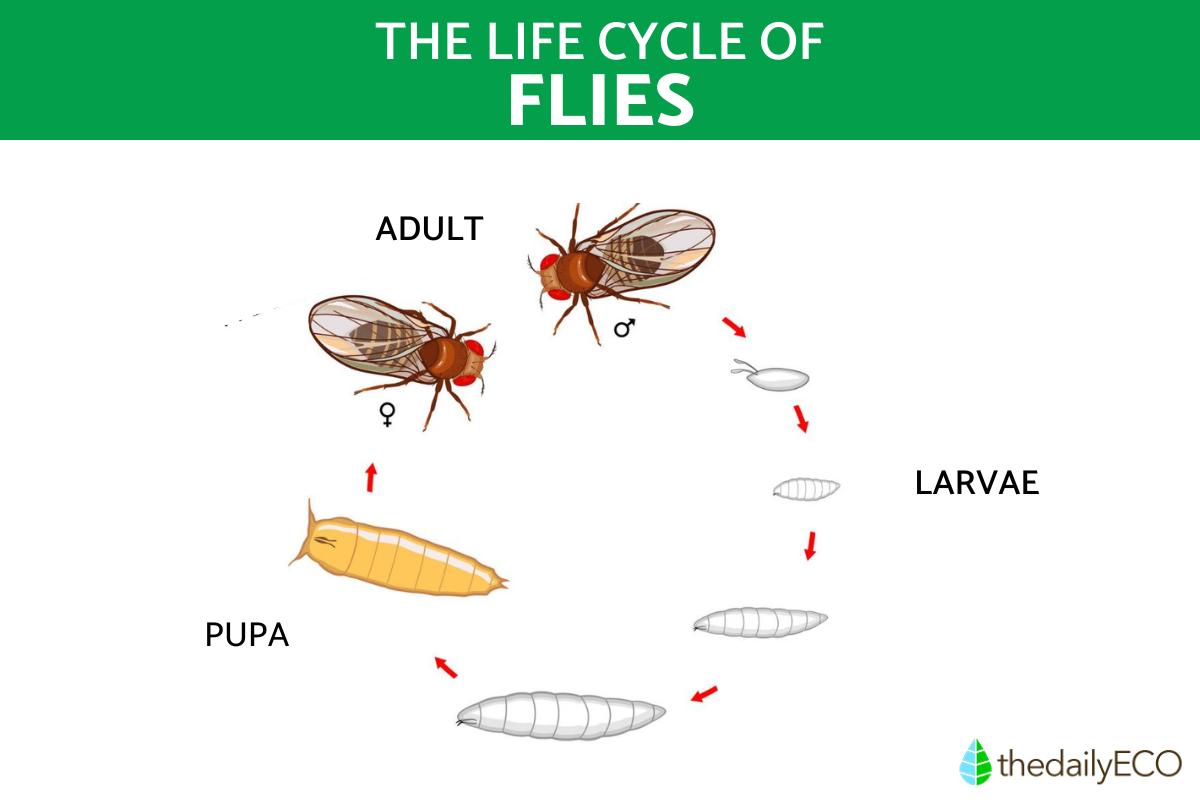The Life Cycle of Flies - How Long Do Flies Live?


Flies, belonging to the order Diptera, are one of the most abundant and diverse groups of insects found across the globe. The life cycle of flies is marked by rapid growth and remarkable reproductive capabilities. Flies are known for their short lifespan, but their ability to reproduce quickly ensures their population remains plentiful. Understanding the life cycle of flies is essential for effective pest control, public health management, and ecological studies.
In this thedailyECO article, we will delve into each stage of the fly's life cycle, exploring the unique characteristics and adaptations exhibited by these resilient insects.
Flies are a diverse group of insects belonging to the order Diptera, which is one of the largest insect orders, consisting of over 150,000 known species.
They are characterized by having a single pair of wings, as opposed to most other insects that have two pairs. The name "Diptera" comes from the Greek words "di," meaning two, and "ptera," meaning wings.
Flies can be found in almost every terrestrial habitat on Earth, from the hot deserts to the cold Arctic regions. They come in various shapes, sizes, and colors, ranging from tiny fruit flies to large horse flies.
Flies are incredibly adaptable and have successfully colonized diverse environments, including urban areas, forests, wetlands, and agricultural fields.
These insects play important roles in ecosystems as both pollinators and decomposers. Many flies are efficient pollinators, transferring pollen from one flower to another while seeking nectar or other food sources. Additionally, flies play a vital role in recycling organic matter by decomposing dead organisms and organic waste, aiding in nutrient cycling.
While some fly species are beneficial, others can be considered pests due to their potential to spread diseases or cause annoyance. Examples of such pest species include house flies, fruit flies, and mosquitoes. These insects can transmit pathogens to humans and animals, contributing to the spread of diseases like malaria, dengue fever, and various bacterial infections.
Do not miss this other article where we explain how do insects breathe.
What is the life cycle of flies?
The life cycle of flies, like most insects, consists of four distinct stages: egg, larva (maggot), pupa, and adult. This life cycle is known as complete metamorphosis, where the insect undergoes significant changes in form and structure during its development.
Egg stage
The life cycle begins when an adult female fly lays eggs. The eggs are usually laid in or near suitable food sources, such as decaying organic matter or animal waste. The number of eggs laid and the time it takes for them to hatch vary depending on the fly species. In favorable conditions, eggs typically hatch within a few hours to a few days.
Larva (Maggot) stage
Once the eggs hatch, they give rise to larvae, commonly referred to as maggots. Maggots are legless, worm-like creatures with soft bodies. They actively feed on the available organic matter, including decaying vegetation, animal remains, or even living organisms in the case of parasitic fly species. The larval stage is the most active feeding phase, and maggots go through multiple molts to accommodate their growing bodies. Larval development can last from a few days to several weeks, depending on the species and environmental conditions.
Pupa stage
When the larva has completed its growth, it enters the pupa stage. The pupa is an inactive, non-feeding stage characterized by the formation of a protective casing or cocoon. Inside this casing, dramatic transformations occur as the larval tissues undergo restructuring and reorganization. This process is known as metamorphosis. The pupa stage is often spent buried in soil or hidden in a secure location to protect the developing fly. During this stage, the insect's body undergoes profound changes, including the development of wings, legs, and other adult structures. The duration of the pupal stage varies widely among fly species and can range from a few days to several months, depending on factors like temperature and species.
Adult stage
After completing the pupal development, the mature fly emerges from the pupal case as an adult. The adult fly has fully functional wings and reproductive organs. It will seek out food sources, mate, and lay eggs to initiate a new life cycle. The adult stage is the reproductive phase of the fly's life cycle and can last from a few days to several weeks or months, again depending on the species.

How do flies reproduce?
Flies reproduce sexually, meaning that both male and female flies are involved in the process of reproduction. Reproduction in flies is highly efficient, and females can lay numerous eggs in a single reproductive event. Some fly species, like the common housefly, can produce multiple batches of eggs throughout their lifespan, contributing to their rapid population growth and abundance.
Male flies typically initiate the mating process by detecting and pursuing receptive females. They may engage in behaviors such as aerial displays, pheromone release, or physical interactions to attract and court females. Once a male successfully mates with a female, the sperm is transferred to the female's reproductive system.
Female flies possess specialized reproductive organs where they can store sperm received during mating. This enables them to fertilize multiple batches of eggs without the need for repeated mating. The duration of sperm storage can vary depending on the species, ranging from a few days to several weeks or even months.
After the mating process, females are ready to lay eggs. The specific location where a female fly deposits her eggs depends on the species and its ecological preferences. Common sites for egg deposition include decaying organic matter, animal waste, fruits, or plant tissues. Flies have evolved adaptations to ensure that their eggs are placed in environments suitable for the survival and development of their offspring.
Once the eggs are laid, embryonic development begins within each egg. The time it takes for the eggs to hatch into larvae (maggots) varies depending on the fly species and environmental conditions such as temperature and humidity.
You might be interested in this other article, where we discuss if bees die after stinging.

How long do flies live?
Flies have evolved to have shorter lifespans but reproduce quickly, enabling them to take advantage of available resources and adapt to changing environments. Their ability to reproduce rapidly ensures the survival and proliferation of their species, even in challenging conditions.
The lifespan of flies can vary significantly depending on the species, environmental factors, and individual circumstances. In general, most fly species have relatively short lifespans compared to many other insects. However, it's important to note that the specific lifespan can differ between different fly species. Here are some general estimations:
- Houseflies (Musca domestica): 15 to 30 days.
- Fruit flies (Drosophila melanogaster): 8 to 10 days.
- Blowflies (Calliphoridae family): few weeks to a couple of months.
- Horseflies (Tabanidae family): 2 to 4 weeks.
It's important to keep in mind that these lifespan estimations are generalizations and can vary based on factors such as temperature, availability of food and water, predation, and overall environmental conditions.
You might be interested in this other article, where we discuss whether mosquitoes have teeth.
If you want to read similar articles to The Life Cycle of Flies - How Long Do Flies Live?, we recommend you visit our Wild animals category.
- Hickman, C. P. et al. (2009): Integral principles of Zoology. McGraw-Hill , Madrid.
- Pietropaolo, S., Beldomenico, MJ, Quiroga, PM & Anibal, M. (2018) Eco-epidemiology of parasitic flies of the genus Philornis Meinert (Diptera: Muscidae) from Argentina: effects of climate variability on their life cycles and impact on the health of their hosts. Retrieved from: https://bibliotecavirtual.unl.edu.ar:8443/handle/11185/1110







